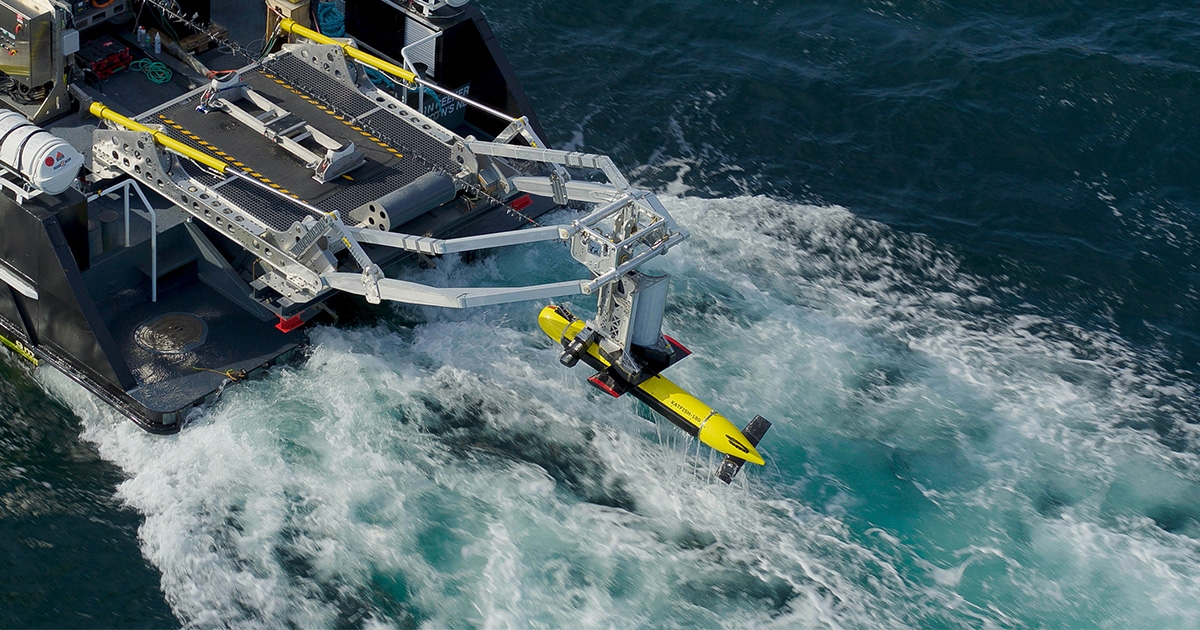The Future of Subsea UXO Detection

With new, ambitious targets set for renewable energy output, the world is turning to its oceans to act as a reliable source, whether wind, waves, or tides. Meticulous planning, construction, and operation of safe infrastructure wholly rely on contextual understanding both on and below the seabed.
One of the more pertinent threats to offshore wind development comes from the remnants of bygone conflicts—bombs and munitions or Unexploded Ordnance (UXO) left behind during successive wars. With an estimated 1.3 million tons of explosives in the marine environment, UXOs pose a serious risk to offshore renewable energy production.
UXO RISK ASSESSMENT
To reduce construction and operational risks, marine developments must begin with a comprehensive UXO risk assessment, eventually leading to an “as low as reasonably practicable” (ALARP) sign-off, confirming the UXO risk is reasonably mitigated. Risk assessments typically begin with detailed desktop studies provided by industry experts, eventually leading to seabed surveys using multibeam echosounder, side-scan sonar, and magnetometry. While cost-effective, broad-sweeping, and reasonably swift to acquire, the result of these surveys is often a listing of hundreds, even thousands, of targets requiring further investigation by a Remotely Operated Vehicle (ROV) or divers before possible removal and disposal.
The drawback with perceived cost-effective solutions is that the resolutions achieved (0.3 m at best) from side scan sonar data coupled with the magnetic information can often lead to significant false positives. Indeed, approximately 95% of potential UXO targets identified during initial surveys turn out to be false positives—either marine debris or simply magnetic content within the seabed sediment. Given the dynamic nature of seabeds in the marine environment, there is always the likely possibility that potential targets have long since been buried and cannot be ruled out by seabed mapping methodologies alone.
The necessity to reduce the risk of encountering UXOs during the construction phase and to achieve ALARP sign-off for each target can lead to heavy disruptions to a development schedule, resulting in time and cost overrun. Considering up to 95% of this overrun is due to false positives, the offshore industry requires more sophisticated survey techniques to help reduce these delays as much as possible.
SYNTHETIC APERTURE SONAR (SAS)
Kraken Robotics, and its subsidiary PanGeo Subsea, offer specialized survey solutions to help bring the risk of encountering UXOs in the marine environment. Kraken's KATFISH system is a high-speed, actively stabilized vehicle utilizing Synthetic Aperture Sonar (SAS) to acquire seabed data with 2 cm constant resolution across a 400 m swath. Acquired alongside IHO-certified multibeam data from the same tow-vehicle, SAS is then draped to produce super-high resolution 3D imaging in post-processing. KATFISH operates up to 10kts survey speeds and can be deployed up to sea state 5, thanks to its intelligent winch and autonomous launch and recovery system. Coupling super-high data resolution and robust operational capabilities mean KATFISH offers an unparalleled seabed mapping solution to image potential UXO on the seabed.
Offering high-resolution 3D imagery below the seabed with its Sub-Bottom ImagerTM (SBI) system, PanGeo has proven to provide solutions to offshore wind developers by reducing potential UXO investigation targets. Using SAS and proprietary beamforming technology, the SBI offers real-time 10 cm resolution data, penetrating up to 8 m below the seabed. Using a multichannel array of acoustic sensors, the SBI uses the acoustic data that scatters off the sides of targets to provide a high-resolution image of an object's exterior. Geoscientists can then interpret this data to provide reports to the developer's UXO consultant in real-time offshore. Being able to visualize the shape of an acoustic target and understanding its dimensions gives UXO experts far more confidence to assess its potential as a threat. With this, a developer's target list is regularly reduced by 70%.
While the SBI excels as a complementary tool to existing survey methodologies, building on broadly acquired magnetometer and seabed mapping data, acoustics is essential when considering that not all bombs and munitions are made of highly-ferrous material. Frequently, magnetometry surveys leave non-ferrous mines undetected, and while they are far less common, this characteristic makes them even more threatening. The beauty of acoustics lies in its fundamentals, imaging density changes, meaning the only requirement to image intact buried munitions is for the density of the seabed surrounding the object to be different from the object itself. With this in mind, the SBI is the premier tool for identifying non-ferrous buried UXO in the marine environment and has helped developers globally in this capacity.
HIGH-SPEED DATA INTEGRITY
Coupling Kraken’s SAS and PanGeo’s SBI data—which can be acquired from the same mobilized vessel—paints the ultimate picture for clients when considering UXO. Unrivalled seabed data offers the ultimate confidence when considering a UXO threat, coupled with market-beating imaging of the sub-seabed; never before have developers had such a clear image of what’s going on beyond the surficial layer of their site.
The correct questions are being asked; how can detection surveys be carried out faster; how can the systems be more readily available; how can large data volumes be processed more efficiently? Kraken Robotics is investing heavily in R&D to answer those questions. Answers which will lead to a common goal of bringing renewable energy online faster. Smaller towed platforms, compatible with more industry-standard equipment, are being designed, allowing the company to react to client requirements more readily and with greater availability.
Investments in high-speed data links bring the data to shore much faster, and machine learning is being used to increase data processing efficiencies on a massive scale.
Kraken Robotics and PanGeo Subsea plan to continue their positive disruption of the offshore survey industry by offering market-leading acquisition speeds coupled with unbeaten data resolution. Swift operations and speedier delivery of results allow developers to plan their construction phases with a better understanding of their site conditions, ultimately reducing delays and costs.
To learn more, visit: www.krakenrobotics.com.
This feature originally appeared in Ocean News & Technology's Magazine December 2022 edition. To read more, access the magazine here.

